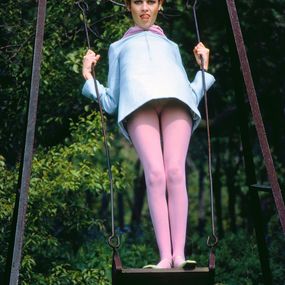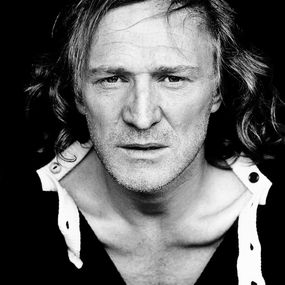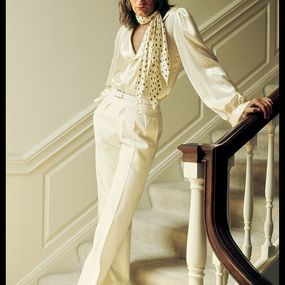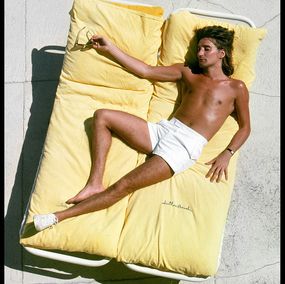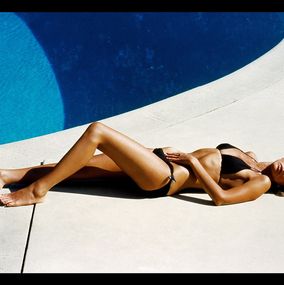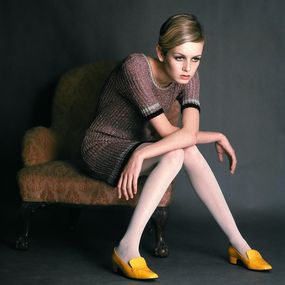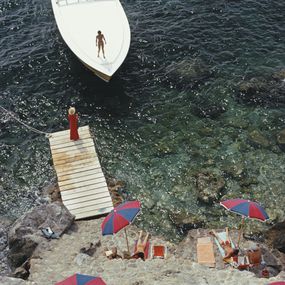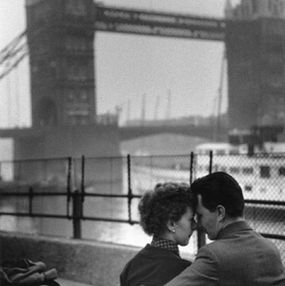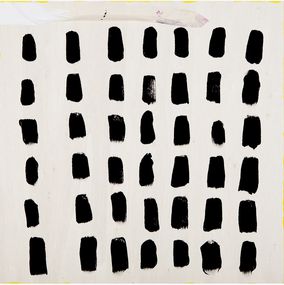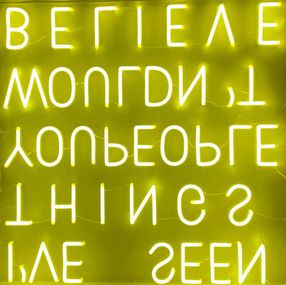
Rudolf Nureyev Applying His Make-up 1976,
1976
David Steen
Photography : silver print
111 x 78 x 0.01 cm 43.7 x 30.7 x 0 inch
Second NOT DISPLAYED BLUR TEXT
Free returns within 14 days
Authenticity guaranteed
Learn moreSecure payment
About the artwork
Type
Numbered and limited to 20 copies
1 copy available
Signature
Not Signed
Authenticity
Invoice from the gallery
Medium
Dimensions cm • inch
111 x 78 x 0.01 cm 43.7 x 30.7 x 0 inch Height x Width x Depth
Support
Framing
Not framed
Artwork sold in perfect condition
Artwork location: United Kingdom
Limited Edition: All prints are limited editions, no further prints are produced once sold.
Paper size - 44 x 31 " / 111 x 78 cm.
Limited to 20 only this size.
All prints are bespoke and printed to order.
stamped and numbered by the Estate.
Copyright: © David Steen / The David Steen Archive
Rudolf Nureyev
In this name that follows Eastern Slavic naming conventions, the patronymic is Khametovich and the family name is Nureyev.
Rudolf Khametovich Nureyev (17 March 1938 – 6 January 1993) was a Soviet-born ballet dancer and choreographer. Nureyev is regarded by some as the greatest male ballet dancer of his generation.
Nureyev was born on a Trans-Siberian train near Irkutsk, Siberia, Soviet Union, to a Tatar family. He began his early career with the company that in the Soviet era was called the Kirov Ballet (now called by its original name, the Mariinsky Ballet) in Leningrad. He defected from the Soviet Union to the West in 1961, despite KGB efforts to stop him.
This was the first defection of a Soviet artist during the Cold War, and it created an international sensation. He went on to dance with The Royal Ballet in London and from 1983 to 1989 served as director of the Paris Opera Ballet. Nureyev was also a choreographer serving as the chief choreographer of the Paris Opera Ballet. He produced his own interpretations of numerous classical works, including Swan Lake, Giselle and La Bayadère.
Early life
Nureyev's grandfather, Nurakhmet Fazlievich Fazliev, and his father, Khamit Fazleevich Nureyev (1903–1985), were from Asanovo in the Sharipov volost of the Ufa District of the Ufa Governorate (now the Ufa District of the Republic of Bashkortostan). His mother, Farida Agliullovna Nureyeva (Agliullova) (1907–1987), was born in the village of Tatarskoye Tyugulbaevo, Kuznechikhinsky volost, Kazan Governorate (now Alkeyevsky District of the Republic of Tatarstan).
Nureyev was born on a Trans-Siberian train near Irkutsk, Siberia, while his mother Farida was travelling to Vladivostok, where his father Khamet, a Red Army political commissar, was stationed.
He was raised as the only son with three older sisters in a Tatar Muslim family.
In his autobiography, Nureyev noted about his Tatar heritage: "My mother was born in the beautiful ancient city of Kazan. We are Muslims. Father was born in a small village near Ufa, the capital of the Republic of Bashkiria. Thus, on both sides our relatives are Tatars and Bashkirs. I cannot define exactly what it means to me to be a Tatar, and not a Russian, but I feel this difference in myself. Our Tatar blood flows somehow faster and is always ready to boil".
Career
Education at Vaganova Academy
When his mother took Nureyev and his sisters into a performance of the ballet Song of the Cranes, he fell in love with dance.[8] As a child, he was encouraged to dance in Bashkir folk performances and his precocity was soon noticed by teachers who encouraged him to train in Leningrad (now Saint Petersburg). On a tour stop in Moscow with a local ballet company, Nureyev auditioned for the Bolshoi ballet company and was accepted. However, he felt that the Mariinsky Ballet school was the best, so he left the local touring company and bought a ticket to Leningrad.
Owing to the disruption of Soviet cultural life caused by World War II, Nureyev was unable to enroll in a major ballet school until 1955, aged 17, when he was accepted by the Vaganova Academy of Russian Ballet of Leningrad, the associate school of the Mariinsky Ballet. The ballet master Alexander Ivanovich Pushkin took an interest in him professionally and allowed Nureyev to live with him and his wife.
Principal with Kirov Ballet
Upon his graduation in 1958, Nureyev joined the Kirov Ballet (now Mariinsky). He moved immediately beyond the corps level, and was given solo roles as a principal dancer from the outset. Nureyev regularly partnered with Natalia Dudinskaya, the company's senior ballerina and wife of its director, Konstantin Sergeyev. Dudinskaya, who was 26 years his senior, first chose him as her partner in the ballet Laurencia.
Before long, Nureyev became one of the Soviet Union's best-known dancers. From 1958 to 1961, in his three years with the Kirov, he danced 15 roles, usually opposite his partner, Ninel Kurgapkina, with whom he was very well paired, although she was almost a decade older than he was.
Nureyev and Kurgapkina were invited to dance at a gathering at Khrushchev's dacha, and in 1959 they were allowed to travel outside the Soviet Union, dancing in Vienna at the International Youth Festival. Not long after, he was told by the Ministry of Culture that he would not be allowed to go abroad again.[16] In one memorable incident, Nureyev interrupted a performance of Don Quixote for 40 minutes, insisting on dancing in tights and not in the customary trousers. He relented in the end, but his preferred dress code was adopted in later performances.
Defection at Paris airport
By the late 1950s, Nureyev had become a sensation in the Soviet Union and though Nureyev's rebellious character and non-conformist attitude made him an unlikely candidate for the tour with the as Kirov Ballet, it became more essential he join the tour which the Soviet government considered crucial to its ambitions to demonstrate its "cultural supremacy" over the West.
Furthermore, tensions were growing between Nureyev and the Kirov's artistic director Konstantin Sergeyev, who was also the husband of Nureyev's former dance partner Natalia Dudinskaya.
After a representative of the French tour organisers saw Nureyev dance in Leningrad in 1960, the French organisers urged Soviet authorities to let him dance in Paris, and he was allowed to go.
In Paris, his performances electrified audiences and critics. Oliver Merlin in Le Monde wrote,
I will never forget his arrival running across the back of the stage, and his catlike way of holding himself opposite the ramp. He wore a white sash over an ultramarine costume, had large wild eyes and hollow cheeks under a turban topped with a spray of feathers, bulging thighs, immaculate tights. This was already Nijinsky in Firebird.
Nureyev was seen to have broken the rules about mingling with foreigners and allegedly frequented gay bars in Paris, which alarmed the Kirov's management[19] and the KGB agents observing him. The KGB wanted to send him back to the Soviet Union. On 16 June 1961 when the Kirov company gathered at Le Bourget Airport in Paris to fly to London, Sergeyev took Nureyev aside and told him that he must return to Moscow for a special performance in the Kremlin, rather than go on to London with the rest of the company. Nureyev became suspicious and refused.
Next he was told that his mother had fallen severely ill and he needed to go home immediately to see her.
Nureyev refused again, believing that on return to the USSR he was likely to be imprisoned.
With the help of French police and a Parisian socialite friend, Clara Saint, who had been engaged to Vincent Malraux, the son of the French Minister of Culture, André Malraux, Nureyev escaped his KGB minders and asked for asylum. Sergeyev and the KGB tried to dissuade him, but he chose to stay in Paris.
Within a week, he was signed by the Grand Ballet du Marquis de Cuevas and performed The Sleeping Beauty with Nina Vyroubova.
On a tour of Denmark he met Erik Bruhn, soloist at the Royal Danish Ballet.
Bruhn became his lover, his closest friend and his protector until Bruhn's death in 1986.
He and Bruhn both appeared as guest dancers with the newly formed Australian Ballet at Her Majesty's Theatre, Sydney in December 1962.
Soviet authorities made Nureyev's father, mother and dance teacher Pushkin write letters to him, urging him to return, without effect.
Although he petitioned the Soviet government for many years to be allowed to visit his mother, he was not allowed to do so until 1987, when his mother was dying and Mikhail Gorbachev consented to the visit.
In 1989, he was invited to dance the role of James in La Sylphide with the Mariinsky Ballet at the Mariinsky Theatre in Leningrad.
The visit gave him the opportunity to see many of the teachers and colleagues he had not seen since his defection.
The Royal Ballet
Principal dancer
Dame Ninette de Valois offered him a contract to join The Royal Ballet as Principal Dancer. During his time at the company, however, many critics became enraged as Nureyev made substantial changes to the productions of Swan Lake and Giselle.
Nureyev stayed with the Royal Ballet until 1970, when he was promoted to Principal Guest Artist, enabling him to concentrate on his increasing schedule of international guest appearances and tours. He continued to perform regularly with The Royal Ballet until committing his future to the Paris Opera Ballet in the 1980s.
Fonteyn and Nureyev
Nureyev's first appearance with prima ballerina Dame Margot Fonteyn was in a ballet matinée organised by The Royal Ballet: Giselle, 21 February 1962.
The event was held in aid of the Royal Academy of Dance, a classical ballet teaching organisation of which she was president. He danced Poème Tragique, a solo choreographed by Frederick Ashton, and the Black Swan pas de deux from Swan Lake. They were so well received that Fonteyn and Nureyev proceeded to form a partnership that endured for many years. They premiered Romeo and Juliet for the company in 1965.[28] Fans of the duo would tear up their programmes to make confetti to throw at the dancers. Nureyev and Fonteyn sometimes did more than 20 curtain calls.
A film of this performance was made in 1966 and is available on DVD.
On 11 July 1967, Fonteyn and Nureyev, after performing in San Francisco, were arrested on nearby roofs, having fled during a police raid on a home in the Haight-Ashbury district.
They were bailed out, and charges of disturbing the peace and visiting a place where marijuana was used were dropped later that day for lack of sufficient evidence.
Other international appearances
Among many appearances in North America, Nureyev developed a long-lasting connection with the National Ballet of Canada, appearing as a guest artist on many occasions. In 1972, he staged a spectacular new production of Sleeping Beauty for the company, with his own additional choreography augmenting that of Petipa. The production toured widely in the U.S. and Canada after its initial run in Toronto, one performance of which was televised live and subsequently issued on video.
Among the National Ballet's ballerinas, Nureyev most frequently partnered with Veronica Tennant and Karen Kain. In 1975 Nureyev worked extensively with American Ballet Theatre resurrecting Le Corsaire with Gelsey Kirkland.
He recreated Sleeping Beauty, Swan Lake, and Ramonda with Cynthia Gregory.
Gregory and Brun joined Nureyev in a pas des trois from the little-known August Bournonville ballet La Ventana.
Director of the Paris Opera Ballet
In January 1982, Austria granted Nureyev citizenship,
ending more than twenty years of statelessness.
In 1983, he was appointed director of the Paris Opera Ballet, where, as well as directing, he continued to dance and to promote younger dancers. He remained there as a dancer and chief choreographer until 1989. Among the dancers he mentored were Sylvie Guillem, Isabelle Guérin, Manuel Legris, Elisabeth Maurin, Élisabeth Platel, Charles Jude, and Monique Loudières.
His artistic directorship of the Paris Opera Ballet was a great success, lifting the company out of a dark period. His The Sleeping Beauty remains in the repertoire and was revived and filmed with his protégé Manuel Legris in the lead.
Despite advancing illness towards the end of his tenure, he worked tirelessly, staging new versions of old standbys and commissioning some of the most ground-breaking choreographic works of his time. His own Romeo and Juliet was a popular success.
When he was sick towards the end of his life, he worked on a final production of La Bayadère which closely follows the Mariinsky Ballet version he danced as a young man.
David Steen
David Steen’s introduction to photography was as a 15-year-old school leaver joining Picture Post where he had the good luck to be taken under the wing of the legendary Bert Hardy as an assistant. It was the ultimate training ground in photojournalism, and the launch pad for his career.
David’s reunion with Picture Post after doing his National Service (as special photographer based in Eygpt, covering the major trouble zones) was short-lived. The magazine was losing ground and closed. He moved to Fleet Street, first to a bright new Mirror title, Woman’s Sunday Mirror, where incidentally he picked up First Prize in Encyclopaedia Britannica’s Best Pictures of the Year Award for his sequence of ‘Birth of a Baby’, the progress of a young woman delivering her own baby under hypnosis.
He was 21, the youngest ever to be awarded this prize. There followed time as a staff photographer with The Daily Mail; Fleet Street was the hub of the world. Then on to freelancing…Queen magazine, Nova, the Sunday Times Magazine, international magazines around the world, over the years covering projects as diverse as riots in Harlem to a film set in Acapulco, a battered wives’ refuge to the Queen and family at Sandringham: the hopeless, the homeless, the glitterati. Trained on the maxim ‘every picture tells a story’ he has focused on film stars, actors, criminals, politicians, prime ministers and countless men, women and children going about their everyday lives.
David Steen believes himself to be lucky. He thinks lucky; luck is being in the right place at the right time, having the luck to have a loving family and enduring friends and winning a three-year battle against cancer.
Asked by aspiring photographers for his best advice, his stock reply is: ‘Get up early.’
David Steen † 1936 – 2015
Imagine it at home

Discover more by the artist
Presentation
David Steen's introduction to photography was as a 15-year-old school leaver joining Picture Post where he had the good luck to be taken under the wing of the legendary Bert Hardy as an assistant. It was the ultimate training ground in photojournalism, and the launch pad for his career.
David's reunion with Picture Post after doing his National Service (as special photographer based in Eygpt, covering the major trouble zones) was short-lived. The magazine was losing ground and closed. He moved to Fleet Street, first to a bright new Mirror title, Woman's Sunday Mirror, where incidentally he picked up First Prize in Encyclopaedia Britannica's Best Pictures of the Year Award for his sequence of 'Birth of a Baby', the progress of a young woman delivering her own baby under hypnosis.
He was 21, the youngest ever to be awarded this prize. There followed time as a staff photographer with The Daily Mail; Fleet Street was the hub of the world. Then on to freelancing…Queen magazine, Nova, the Sunday Times Magazine, international magazines around the world, over the years covering projects as diverse as riots in Harlem to a film set in Acapulco, a battered wives' refuge to the Queen and family at Sandringham: the hopeless, the homeless, the glitterati. Trained on the maxim 'every picture tells a story' he has focused on film stars, actors, criminals, politicians, prime ministers and countless men, women and children going about their everyday lives.
David Steen believes himself to be lucky. He thinks lucky; luck is being in the right place at the right time, having the luck to have a loving family and enduring friends and winning a three-year battle against cancer.
Asked by aspiring photographers for his best advice, his stock reply is: 'Get up early.'
David Steen † 1936 – 2015
More works from GALERIE PRINTS
Artsper delivers internationally. The list of countries is available in the first step of your cart.
If your country is not listed contact us at [email protected] and we will see what we can do.
Note that Customs fees may apply for works shipped internationally. This is indicated in the first step of the shopping cart.
You can choose a delivery address different from the billing address. Make sure that a trusted person is present to receive the work if you cannot be there.
Have you purchased a painting, sculpture or work on paper?
Find our expert advice for the conservation and promotion of your works in the articles below:
Artsper offers you access to more than 200,000 works of contemporary art from 2,000 partner galleries. Our team of experts carefully selects galleries to guarantee the quality and originality of the works.
You benefit from:
-
Works at gallery price
-
Return within 14 days, regardless of your location
-
Easy resale of the work purchased on Artsper
-
Personalized research tools (selection and tailor-made universe)
Our customer service is available for any assistance.
At Artsper, our mission is to allow you to collect works of art with complete peace of mind. Discover the protections we offer at every stage of your shopping experience.
Buy works from top galleries
We work in close collaboration with carefully selected art galleries. Each seller on Artsper is carefully examined and approved by our team, thus ensuring compliance with our code of ethics. You therefore have the assurance of purchasing authentic, high-quality works.
Total transparency: you know what you are buying
Before being posted online, all artwork on Artsper is reviewed and validated by our moderation team. You can browse with complete peace of mind, knowing that each piece meets our criteria of excellence.
Personalized support: our experts at your service
Our team of contemporary art experts is available by phone or email to answer all your questions. Whether you want advice on a work or a tailor-made selection to enrich your collection, we are here to support you.
Resell your works with ease
If you have purchased a work on Artsper and wish to resell it, we offer you a dedicated platform to relist it. To find out more, click here.
Make offers with Artsper: negotiate like in a gallery
You have the possibility to propose a price for certain works, just like in a gallery. This feature allows you to initiate discussions and potentially acquire your coins at advantageous prices.
Get help with your negotiations
Our team will negotiate for you and inform you as soon as the best offer is obtained. Do not hesitate to call on our expertise to ensure a transaction at the best price.
Order securely
Artsper satisfaction assurance
We want you to be completely satisfied with your purchase. If the work you receive is not to your liking, you have 14 days to return it free of charge, and you will be refunded in full, whatever the reason.
Secure payment with Artsper partners
All credit card payments are processed by Paybox, the world leader in payment solutions. Thanks to their strict security standards, you can transact with confidence.
Problem Support
In the rare event that an artwork arrives damaged or not as described, we are here to help. Whether for a return, refund, restoration or exchange, our team will support you throughout the process and will ensure that we find the solution best suited to your situation.
Conditions to benefit from Artsper protections:
-
Use one of the payment methods available on Artsper for your order.
-
Report any problems within one week of receiving the work.
-
Provide required photographic evidence (including original artwork and packaging).
Artsper guarantees cover the following cases:
-
The received work lacks a described characteristic (for example, a signature or frame).
-
The artwork has significant differences from its description (e.g. color variation).
-
The work is damaged upon receipt.
-
The work is lost or damaged by the carrier.
-
Delivery is significantly delayed.
With Artsper, you collect with complete peace of mind.







